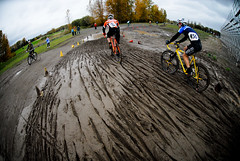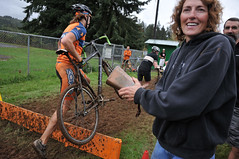Earlier this week, Tori shared some background on cyclocross. Now she’s got some key pointers for your first foray into racing. This weekend offers two great opportunities to get out there. So get out there (but read Tori’s primer first)! — JM
Pre-Race Prep
Practice makes perfect
Whether this is your first season racing or you’d like to freshen up your cyclocross skills, it’s a good idea to do some practice. Most of the clinics in the Portland area have wrapped up (the season gets underway this weekend); but you can grab some friends and head to a local park to do a clinic of your own.
While you’re out there, work on your starts (begin from stopped position and rev up to speed), turns (I like to find trees or poles and turn sharply around them), and balance. Another big thing to work at is getting comfortable carrying your bike and hopping on and off as you continue to roll forward.
If the thought of huge fields and hundreds of screaming fans freaks you out, try a smaller race. The Blind Date at the Dairy series is on Wednesdays and it’s much more mellow than the weekend races. Race lengths are also shorter, which is perfect for beginners.
A well-maintained bike is a fast bike
Bring your racing bike into the shop at least a week or two before to have it checked over and make sure it’s in good working order. Read my previous article to learn more about what kind of bike you’ll need or how to convert the one you have. Most races offer some mechanical ride support from a bike shop or sponsor, but don’t show up counting on them to fix your bike the day of the race. (And please, tip the mechanics. They’re out there for hours in the cold so you can have a great race).
Day of the Race
Get to the race at least an hour and a half before the start time and if you haven’t already pre-registered, leave sooner. When you get to the race, find the OBRA registration tent and sign in or register. They’ll give you your race number and safety pins to secure it to your jersey or shirt. If you’re not sure how to properly pin it on, ask an official or check out these examples. Improperly pinned numbers won’t get counted and they drive the race officials batty.
Arriving early gives you a chance to preview the course and get a sense of what you’re in for during the race. The on-line race schedule on the promoter’s website will have times listed for pre-riding the course. These are the only times anyone is allowed on the course the race day other than during their race. If pre-riding isn’t an option, walk the course which is almost as good.
Bring the clothes you plan to race in, a helmet, gloves and clothes to change into afterwards. A towel is super handy for cleaning off mud and some modesty when changing, as are plastic bags for carrying muddy clothes home.
Also, bring food and water for before and after. Some folks like a shot of energy gel or chews 15-20 minutes before the race. There’s usually not enough time to eat or drink during the race, so eating a good meal a few hours before and hydrating well the day before is your best strategy.
It’s good to warm up a bit before starting, either by working your skills or riding a bit around the parking lot. Get to the starting line 5- 10 minutes before the beginning of you race for announcements and getting lined up.
Bell Lap and the Big Finish
Once the race has started, laps are being counted down near the finish line. If you’ve pre-walked or ridden the course, you’ll see the place to look when you pass through each lap. A bell signals when there is one lap left as riders pass through the finish line the second to the last time. This is the time for racers to drop the hammer and bring it home to sweet victory– or at least relief for struggling lungs.
And for spectators this is a time to shine. In the last lap racers are often in — what is lovingly referred to as “the pain cave” — and can use all the extra encouragement the sidelines can muster. If you’re at the race supporting a friend or loved one, it’s nice to have water and a jacket waiting for them at the finish line and greet them with congrats of a race well ridden.
As soon as possible after racing, racers should be sure to eat real, healthy food — a PBJ, a cup of yogurt, or another healthy snack or meal — to help recovering muscles. As a beverage of choice for recovery some people swear by chocolate milk, others a nice, cold beer. Of course, both also work as excellent motivators to get through the race.
And buy a cone of fries or a warm waffle smothered in Nutella. All this fun is hard work. It won’t be long until the next race where new friends, bravery, challenges, triumphs (and hopefully, a bit of mud) await.
— Tori Bortman is the owner of Gracie’s Wrench and she writes a regular column for BikePortland. You can read her past articles here.






